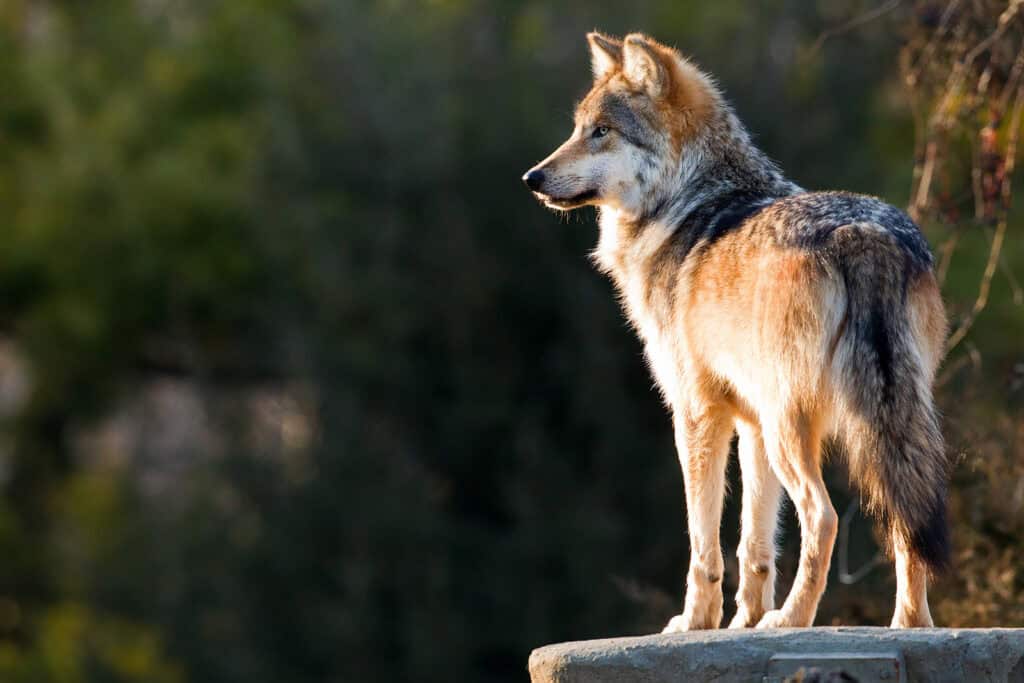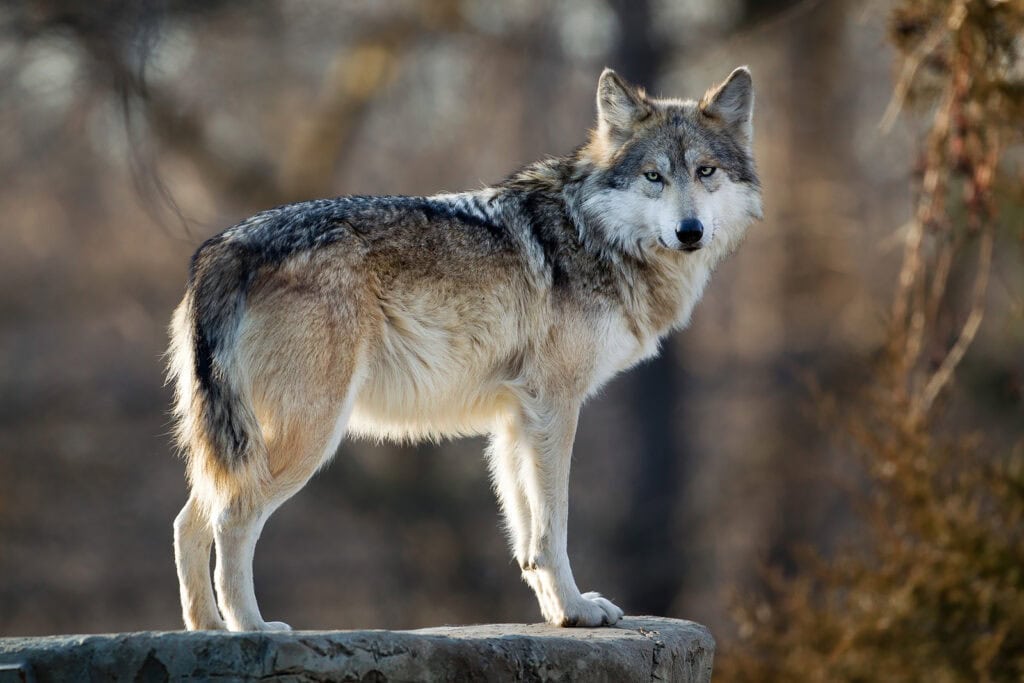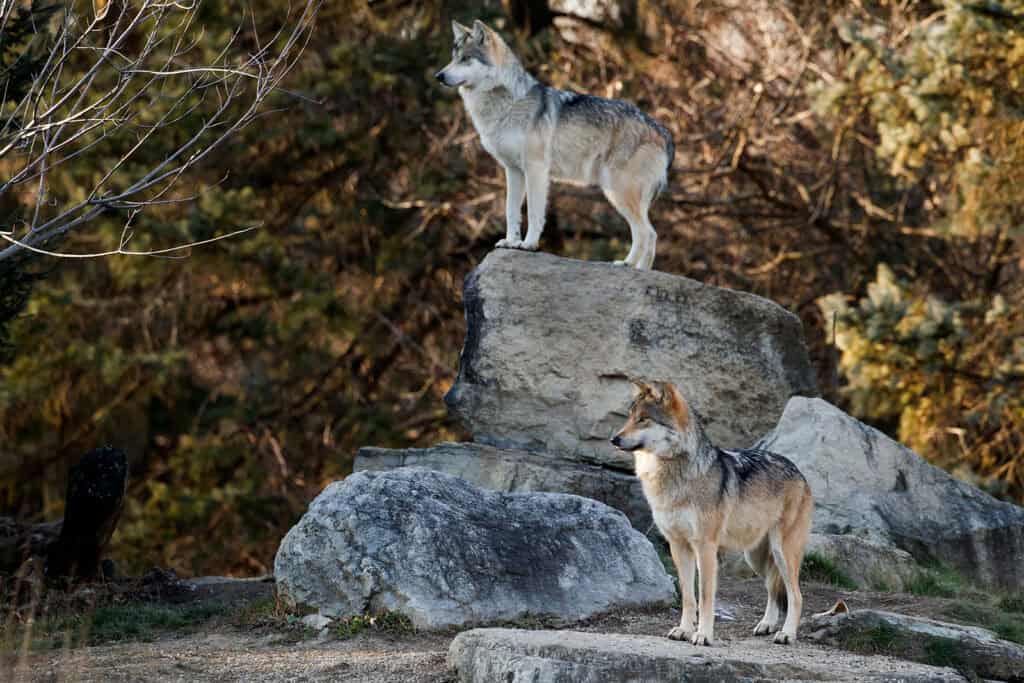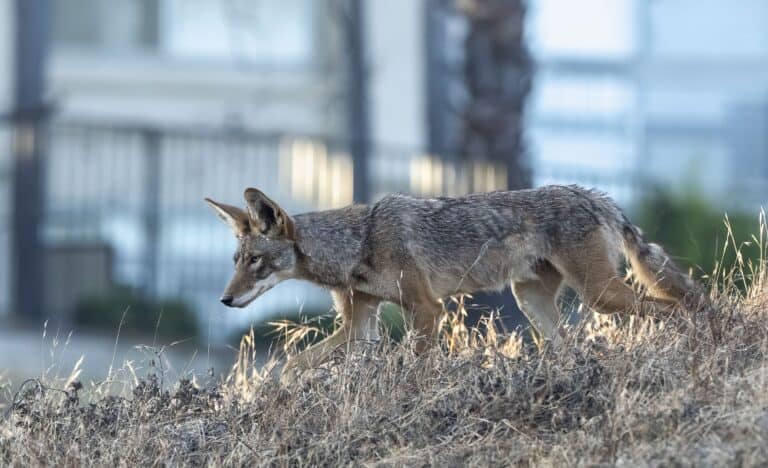Notes From The Field Blog by David Parsons, M.S.
The 25th anniversary of Mexican gray wolf reintroduction in the southwest is upon us. Although there have been laudable successes, the population still faces persecution and other threats today. To celebrate and learn more about the history and current status of this unique subspecies of gray wolf, I encourage you to join Project Coyote and The Rewilding Institute for a joint webinar on March 16th at 12:30 pm MT.
The past:
Overzealous predator eradication programs initiated by the federal government in the early 1900s were effective in killing all Mexican gray wolves (Canis lupus baileyi; aka Lobos) in the wild throughout their entire historic range in the southwestern United States by the mid 1900s and in Mexico around 1980. The Endangered Species Act was passed in the nick of time to save the lobos, the southernmost and most genetically distinct subspecies of gray wolf (Canis lupus) in North America, from certain extinction.
Mexican wolves once roamed the US Southwest and northern Mexico by the thousands. Although an exact population estimate is impossible, wherever there was prey, there were Mexican wolves. And wherever there was adequate moisture and available forage and water sources, there was prey. The best habitat was generally the mid to high elevations in the mountainous regions and the riparian zones along rivers and streams.
Mexican wolves are the smallest subspecies of gray wolves in North America, rarely exceeding 80 pounds for large males. Females are 15 to 20 pounds lighter. Some scientists believe that the epicenter of evolution for the Mexican wolf subspecies was in the Sierra Madres of northern Mexico and Sky Island region of the southwestern United States in southern Arizona and New Mexico. The principal prey in this region was the diminutive Coues whitetail deer—rarely exceeding 100 pounds—and other prey species were likely mule deer, javelina (collared peccary), beavers, jackrabbits, cottontails, and other small mammals.
“Mexican Wolf Documentary by WildEarth featuring Dave Parsons”
A prevailing hypothesis is that Mexican wolves evolved to have smaller body size because of the smaller size of prey available and because of the need to shed more heat in the warm climate of the region. The latter phenomenon is known as Bergmann’s Rule. Nineteenth century German biologist Carl Bergmann observed that within species with broad distributions over a north-south gradient, those in the colder climes had larger bodies than those in the warmer climes. The theory is that a warm-blooded animal’s body surface to volume ratio was important in regulating body temperature by either retaining (smaller surface to volume ratio in large bodied animals) or dissipating (larger surface to volume ratio in small bodied animals) heat. This phenomenon holds true for many wide-ranging species.
As gray wolves radiated across North America from their entry point at the eastern end of the Beringia to their southern-most distribution near the latitude of Mexico City, they evolved and adapted to the variety of climatic and ecological conditions they encountered. Historically, gray wolves were contiguously distributed from the Arctic to Mesoamerica. Variations among subspecies were subtle rather than abrupt, with fuzzy boundaries between the subspecies taxonomists described. But wolves living substantial distances apart along this distribution exhibited measurable physical, genetic, and ecological differences.

Monty Sloan Photography
Mexican wolves at the northern end of their distribution blended into populations that were somewhat larger and preyed on the abundant Merriam’s elk and even bison in adjacent regions. That Mexican wolves reintroduced into the Gila region prey primarily on the transplanted Rocky Mountain elk – Merriam’s elk having been shot to extinction in the early 20th century – is a testament to their evolutionary plasticity.
As European settlers moved west with their large herds of livestock beginning in the late 1800s, two problems occurred simultaneously to permanently alter our Southwestern ecosystems. Unregulated hunting for sport and markets, and apparently just for the hell of it, decimated wildlife populations. And unregulated grazing by cattle and sheep degraded fragile grasslands and riparian ecosystems. Watersheds were laid bare and erosion was unleashed with a vengeance blighting landscapes to a condition that the ecologically unenlightened now perceive as the normal “look” of the West.
Early western cattle barons were politically connected, and convinced Congress to pass legislation to establish a federal agency (now known as USDA “Wildlife Services” and formally known as Animal Damage Control) in 1915 with a mission of eradicating large predators from the land.
The Lobo comeback:
Mexican wolves narrowly escaped extinction with the passage of the Endangered Species Act in 1973 and their placement on the list of endangered species in 1976. A few wild Mexican wolves remained in the remote Sierra Madre in the Mexican states of Chihuahua, Sonora, and Durango. Renowned Texas trapper, Roy McBride, was hired in 1977 to live-trap as many wild Lobos as possible in Mexico. Between 1977 and 1980 he trapped five wild Mexican wolves – four males and one pregnant female. These were placed in captive breeding facilities in the United States and became the “certified” lineage of Mexican wolves for purposes of captive breeding for future reintroduction to their former wild habitats.

Monty Sloan Photography
Concerns over the limited gene pool led to the testing of two additional captive lineages of Mexican wolves, called the Ghost Ranch and Aragon lines. A team of canid geneticists using new molecular genetic and traditional morphological methods determined in 1995 that both of these lines were pure Mexican wolves. This increased the number of certified pure founders for the captive population to seven wolves – three females and four males. All 600+ Mexican wolves alive today in both captivity and the wild can be traced to these seven founders.
Following many years of captive breeding, lengthy analyses of suitable release sites, development of reintroduction proposals, and public reviews, the first eleven Lobos were released into the Apache National Forest in eastern Arizona in 1998. About 180 Mexican wolves have been released up to the present day; and the current wild population inhabiting suitable habitats in Arizona and New Mexico is estimated to be 241 Lobos. More recent releases in Mexico have resulted in a current wild population there hovering around 30-40 wolves.
The challenges Lobos face:
Wild populations of Mexican wolves face serious threats to their long-term survival. Responsible wildlife agencies need to confront these threats for Lobos to regain population levels and sufficient genetic integrity to allow them to be removed from the list of endangered species. The two main threats are limited genetic diversity and excessive human-caused mortality. For the past 20 years, state wildlife agencies have pressured the U.S. Fish and Wildlife Service (USFWS) to limit releases of genetically valuable animals from the captive population. The current wild population has a very high inbreeding coefficient which can lead to genetic problems potentially affecting the lobos’ long-term survival. And the combination of illegal killing and management-related removal of wolves has slowed recovery. About 140 illegal killings have been confirmed to date, but research shows that the actual number of poaching events is likely closer to 300. Few poachers have been prosecuted for illegally killing Mexican wolves.
Recent revisions of the federal rules for managing the wild population and the Mexican Wolf Recovery Plan reflect political influences driven by state wildlife agencies whose policies are disproportionately influenced by hunters and ranchers. Pressure from the Four Corners states’ governors, their governor-appointed game commissions, and New Mexico and Arizona wildlife managers has resulted in the USFWS requiring a dangerously low number of Mexican wolves for removal from the list of endangered species, limited options for releasing wolves from the more genetically diverse captive population, and set a northern limit for Mexican wolf occupation at Interstate 40 in Arizona and New Mexico. The Endangered Species Act requires recovery decisions to be based on the best available science, not politics.

Monty Sloan Photography
USFWS finalized both the Mexican wolf 10(j) management rule and the Mexican wolf recovery plan in 2022 after court ordered revisions. In apparent good news, USFWS eliminated its current population cap of 325 Mexican gray wolves that are allowed to live in the region, an artificially low number that was a hindrance to true species recovery, but “smoke and mirrors” language in the rule ties the population objective for the U.S. population to the recovery plan, which states that only 320 wolves are needed in the U.S. population to achieve full recovery. The management rule still authorizes the removal of all wolves that cross to the north side of I-40. There is no credible scientific justification for these restrictions. The USFWS admits that a single population of this size leaves Mexican wolves highly vulnerable to extinction. Their solution in the recovery plan is to encourage the country of Mexico to establish a second population of at least 200 Mexican wolves. Many scientists believe that 525 wolves in two separate and functionally disconnected populations are insufficient to ensure recovery. Another critical concern is that the USFWS has no authority over recovery actions in Mexico. And, the management rule still rejects science-based reforms that would greatly assist species recovery and increase genetic diversity, such as releasing bonded pairs and their pups. Instead, USFWS continues to pursue cross-fostering, or placing pups born in captivity with wild litters, as the sole method for releasing captive wolves to the wild. Only 14 of the 83 cross-fostered pups that have already been released to unrelated wolves are confirmed alive today. Just four of these wolves are known to have reproduced, and only six of the offspring, all from just one of those four wolves, are known to be alive. Inbreeding in the population fails to significantly improve as the service drags its feet on releases of well-bonded pairs. These politically motivated limits have no defensible scientific basis.
In late 2010 the USFWS appointed a team of independent scientists to a formally established Mexican Wolf Recovery Team. The scientists prepared a draft recovery plan in 2012 which recommended three separate populations, connected by corridors of suitable habitat, in the US Southwest totaling at least 750 wolves with each subpopulation having at least 200 wolves. Locations of two of the three recommended populations were north of I-40, dipping into southern Utah and Colorado. These science-based recovery recommendations and the 268-page draft recovery plan prepared by the independent scientists were rejected by the states and subsequently by the Fish and Wildlife Service. In contrast, the 2017 recovery plan which has since been revised (2022) due to a lawsuit won by conservation plaintiffs was developed in closed sessions primarily between representatives of the four southwestern states, wildlife agencies in Mexico, and the USFWS.
It can be fairly stated that every major advance in the recovery of Mexican wolves was forced by lawsuits filed by conservation groups; and every decision made by the U.S. Fish and Wildlife Service has been adversely influenced by the politics of special interests antithetical to the recovery of the Lobos, especially by the southwestern states, their game and fish departments and commissions.
The future of lobos in the Southwest depends on relentless pressure applied to responsible state and federal agencies and elected officials by dedicated citizen activists, conservation organizations, independent scientists, and conservation-oriented lawyers. For suggestions on what you can do to help save the iconic Lobo of the Southwest please visit the website: www.mexicanwolves.org. Winning conservation battles is hard, but giving up ensures that wild Nature loses.
David Parsons is a Project Coyote Science Advisory Board Member and served as the original coordinator of Mexican gray wolf recovery for the U.S. Fish and Wildlife Service from 1990-1999 when the first Lobos were reintroduced.






